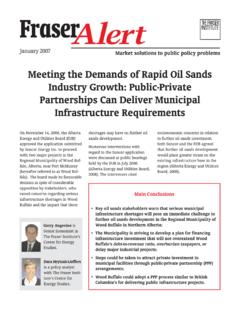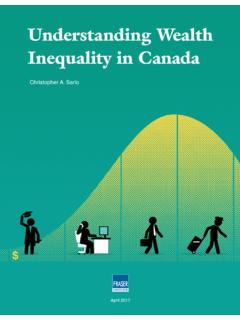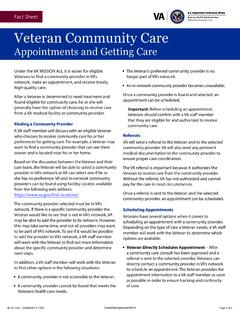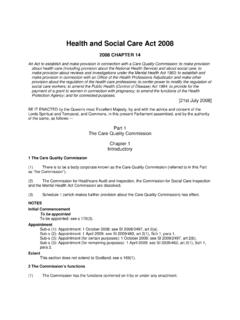Transcription of Reducing Wait Times for Health Care - Fraser Institute
1 Reducing Wait Times for Health care What Canada Can Learn from Theory and International Experience edited by Steven GlobermanReducing Wait Times for Health care edited by Steven GlobermanCopyright 2013 by the Fraser Institute . All rights reserved. No part of this book may be reproduced in any manner whatsoever without written permission except in the case of brief quotations embodied in critical articles and authors of this publication have worked independently and opinions expressed by them are, therefore, their own, and do not necessarily reflect the opinions of the Fraser Institute or its supporters, trustees, or staff.
2 This publication in no way implies that the Fraser Institute , its trustees, or staff are in favour of, or oppose the passage of, any bill; or that they support or oppose any particular political party or of issue: October 2013 Printed and bound in CanadaCover design and artwork Bill C. RayLibrary and Archives Canada Cataloguing in Publication DataReducing Wait Times for Health care : What Canada Can Learn from Theory and International Experience / Steven Globerman (editor)Includes bibliographical references. ISBN d Fraser Institute d iiiContents 1 Introduction / 3 Steven Globerman 2 Measuring How Long Canadians Wait for Health care / 15 Nadeem Esmail 3 The Consequences of Waiting / 45Dr.
3 Brian Day 4 The Inefficiency of Health care Rationing and a Solution / 77 David R. Henderson 5 Health Status of the Workforce and Economic Growth / 95 Steven Globerman 6 Understanding Differences in Wait Times / 119 Nadeem Esmail About the authors / 157 Acknowledgments / 159 Publishing information / 160 Supporting the Fraser Institute / 161 Purpose, funding, and independence / 162 About the Fraser Institute / 163 Editorial Advisory Board / 164 Fraser Institute d d Fraser InstituteReducing Wait Times for Health d Fraser Institute d 3 Chapter 1 IntroductionSteven GlobermanPublic opinion polls in recent years show that Canadians are generally satis-fied with their government-funded Health care If there is any con-sistent source of dissatisfaction with the single-payer system.
4 It is with the amount of time people wait to receive medical As the Fraser Institute has documented in an ongoing series of annual surveys of Health care wait-ing lists, Canadian patients face wait Times for a wide range of Health care services, particularly specialty services and procedures. For example, in 2012 Canadians could expect to wait weeks on average from GP referral to con-sultation with a specialist (ranging from weeks for radiation oncology to 20 weeks for orthopedic surgery). They could also expect to wait weeks on average from specialist appointment to treatment (ranging from weeks for medical oncology treatment to weeks for orthopedic surgery treatment (Barua and Esmail, 2012).)
5 Requiring patients to wait for medical services is the primary way that access to a scarce resource, in this case physicians services, is rationed in most countries characterized by a publicly funded, universally accessible Health 1 Canada does not have a single Health care system, as each province and territory administers its own system. However, the federal government strongly influences most aspects of the provincial systems so that the similarities across provinces are much stronger than the differences. Given the strong similarities across provinces, as well as for convenience, the chapter will simply refer to publicly funded Health care in While medically necessary physician and hospital Health care services are provided to Canadians under the government-funded system, a significant percentage of Health care expen-ditures are paid for primarily by households and through supplemental private insurance plans.
6 The percentage of Health care expenditures paid for privately was of all Health care expen-ditures in Canada in 2010 (CIHI, 2012). Fraser Institute d d Reducing Wait Times for Health Careinsurance system. Conversely, in most markets for goods and services, price is the instrument by which the quantity demanded for the good or service in question is equated to quantity supplied. Thus, if demand exceeds supply at a given price, competition among buyers will lead to a rising price. This, in turn, will encourage an increase in the quantity supplied of the good or service, as well as a decrease in the quantity demanded.
7 Price will keep rising until quantity demanded equals the available quantity supplied. The dynamic will work in the opposite direction if supply exceeds demand at a given price. That is, price will decline until the quantities supplied and demanded are equal. However, under Canada s Medicare system, patients do not pay for even a portion of Health care services directly through co-payments or cost-sharing, since Health care providers cannot charge user As a consequence, the price to patients for using the services of Health care providers is effectively zero, although physicians are paid by the government primarily on a per-service basis.
8 As David Henderson explains in chapter 4 of this volume, the first dollar coverage feature of the government-funded system results in the demand for Health care services exceeding the supply of those services, and some instrument must be substituted in place of price to ration access to Health care . That instrument is waiting purpose of this book is to assess various policy-related issues associated with waiting lists for Health care services in One basic issue is how to measure wait Times for Health care , and whether the estimates reported to date systematically overstate or understate wait Times in Canada.
9 A second is the relevance of waiting lists to public policy. Requiring patients to queue for medical services, rather than ensuring sufficient output to meet the existing demand, presumably saves the government money directly in terms of reduced expenditures on hospitals and doctors, at least in the short-run. 3 If user fees or payments required of consumers were absolutely fixed and unresponsive to supply and demand conditions, they would fail to equate supply and demand at the market-clearing rate of output, although they should discourage excessive use of the Health care system to some In this volume, we will use the terms Health care services and medical services as syn-onyms, although the former will generally encompass a broader range of services, , physical therapy, than the latter.
10 Also, we use the terms waiting lists and wait Times interchangeably although, strictly speaking, they measure different phenomena. Specifically, waiting lists refer to the number of individuals waiting for medical services, whereas wait Times refer to the actual period of waiting experienced by patients. The total time Canadians spend waiting for Health care is obviously the product of the d Fraser InstituteChapter 1: Introduction d 5 However, waiting lists impose indirect costs on those required to wait for Health care , often including anxiety and physical pain and limitations. The larger the indirect costs, the more likely it is that waiting lists have net overall costs for Canadian society.















